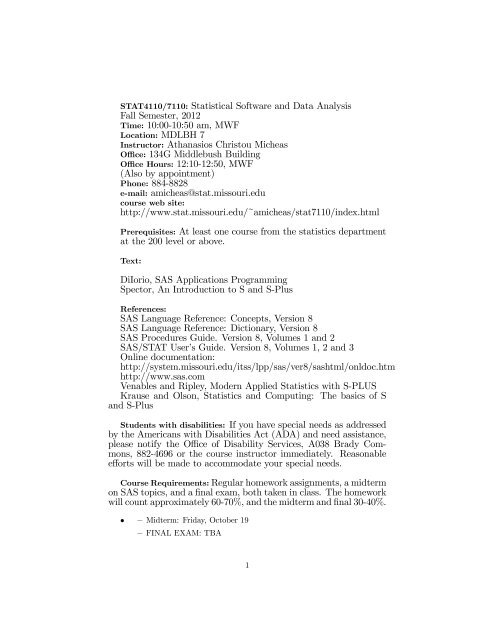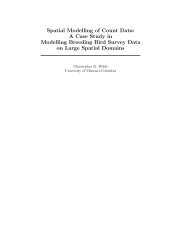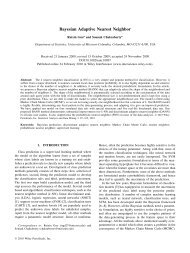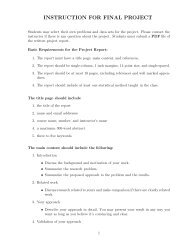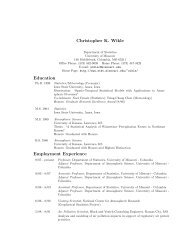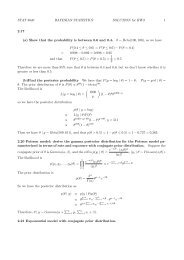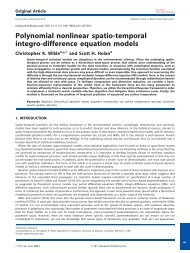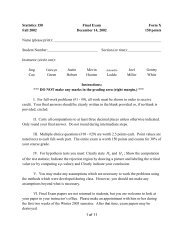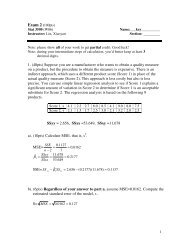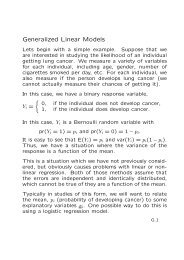STAT4110/7110: Statistical Software and Data Analysis Fall ...
STAT4110/7110: Statistical Software and Data Analysis Fall ...
STAT4110/7110: Statistical Software and Data Analysis Fall ...
Create successful ePaper yourself
Turn your PDF publications into a flip-book with our unique Google optimized e-Paper software.
<strong>STAT4110</strong>/<strong>7110</strong>: <strong>Statistical</strong> <strong>Software</strong> <strong>and</strong> <strong>Data</strong> <strong>Analysis</strong><br />
<strong>Fall</strong> Semester, 2012<br />
Time: 10:00-10:50 am, MWF<br />
Location: MDLBH 7<br />
Instructor: Athanasios Christou Micheas<br />
Office: 134G Middlebush Building<br />
Office Hours: 12:10-12:50, MWF<br />
(Also by appointment)<br />
Phone: 884-8828<br />
e-mail: amicheas@stat.missouri.edu<br />
course web site:<br />
http://www.stat.missouri.edu/~amicheas/stat<strong>7110</strong>/index.html<br />
Prerequisites: At least one course from the statistics department<br />
at the 200 level or above.<br />
Text:<br />
DiIorio, SAS Applications Programming<br />
Spector, An Introduction to S <strong>and</strong> S-Plus<br />
References:<br />
SAS Language Reference: Concepts, Version 8<br />
SAS Language Reference: Dictionary, Version 8<br />
SAS Procedures Guide. Version 8, Volumes 1 <strong>and</strong> 2<br />
SAS/STAT User’s Guide. Version 8, Volumes 1, 2 <strong>and</strong> 3<br />
Online documentation:<br />
http://system.missouri.edu/itss/lpp/sas/ver8/sashtml/onldoc.htm<br />
http://www.sas.com<br />
Venables <strong>and</strong> Ripley, Modern Applied Statistics with S-PLUS<br />
Krause <strong>and</strong> Olson, Statistics <strong>and</strong> Computing: The basics of S<br />
<strong>and</strong> S-Plus<br />
Students with disabilities: If you have special needs as addressed<br />
by the Americans with Disabilities Act (ADA) <strong>and</strong> need assistance,<br />
please notify the Office of Disability Services, A038 Brady Commons,<br />
882-4696 or the course instructor immediately. Reasonable<br />
efforts will be made to accommodate your special needs.<br />
Course Requirements: Regular homework assignments, a midterm<br />
on SAS topics, <strong>and</strong> a final exam, both taken in class. The homework<br />
will count approximately 60-70%, <strong>and</strong> the midterm <strong>and</strong> final 30-40%.<br />
• — Midterm: Friday, October 19<br />
— FINAL EXAM: TBA<br />
1
Homework: Homework assignments will be made <strong>and</strong> collected<br />
throughout the semester. You may work together on these assignments,<br />
but you must formulate <strong>and</strong> write your own solutions. No<br />
credit will be given for answers without supporting work.<br />
• All homework is due at the beginning of class.<br />
• Late homework will not be accepted, except for acts of God,<br />
e.g. medical emergencies or death in the family.<br />
• On SAS assignments, you must turn in all input programs <strong>and</strong><br />
SAS output.<br />
• Annotate your output (either with a word processor or by h<strong>and</strong>)<br />
so that the grader can determine that you have accomplished<br />
the goals of the assignment.<br />
Objectives of the course:<br />
The course illustrates the use of two statistical packages, SAS<br />
<strong>and</strong> R (S-PLUS).<br />
SAS is a statistics software that is widely used in industry, although<br />
there are other popular statistics packages that are easier to<br />
use for PCs <strong>and</strong> Macs. (SPSS, <strong>Statistical</strong> Package for the Social Sciences,<br />
is a notable popular package.) The class focuses on aspects<br />
of statistical programming with SAS not covered in other statistics<br />
department courses. We will initially discuss techniques of data<br />
base management <strong>and</strong> data manipulation. Other SAS capabilities<br />
including the graphics package <strong>and</strong> the interactive data visualization<br />
package, PROC INSIGHT, will be discussed in addition to the basic<br />
techniques for one <strong>and</strong> two sample problems, analysis of variance,<br />
linear regression, <strong>and</strong> categorical data.<br />
R is a freeware statistical package that is essentially the free analog<br />
of S-PLUS which was an increasingly popular statistical programming<br />
language. There are minor differences between the two<br />
languages (syntax wise etc). Of course S-PLUS is not free... Both<br />
are object-oriented languages with a number of modern statistical<br />
capabilities not generally available elsewhere. R/S-PLUS is easily<br />
extensible; new capabilities are readily added, either from public<br />
domain packages or by writing your own programs. In addition,<br />
R/S-PLUS has perhaps the most powerful graphics capabilities of<br />
any statistics package since the main routines are very amenable to<br />
changes.<br />
2
Topics to be covered:<br />
SAS<br />
• language basics: variable types <strong>and</strong> names, syntax<br />
• dataset structure<br />
• input: list, informats, pointer control, iterated formats<br />
• basic procedures: print, means, univariate, sort, chart<br />
• normal probability plotting<br />
• SAS functions including r<strong>and</strong>om number generation, quantiles,<br />
percentiles<br />
• DO statement<br />
• arrays<br />
• SAS datasets–permanent, libraries<br />
• merge <strong>and</strong> update<br />
• proc format; recoding<br />
• plotting: proc plot, proc gplot<br />
• statistical methods: proc means, ttest, reg, freq, anova, glm<br />
• Introduction to macros (time permitted)<br />
R/S-Plus<br />
• primitives: vectors, list, matrix, data.frame<br />
• matrix operations<br />
• descriptive statistics: histograms, boxplots, stem plots<br />
• functions including r<strong>and</strong>om number generation, quantiles <strong>and</strong><br />
percentiles of common distributions<br />
• basic methods including parametric <strong>and</strong> nonparametric one <strong>and</strong><br />
two sample problems, contingency tables, regression <strong>and</strong> anova<br />
• loops<br />
• writing programs<br />
• linked plots, scatterplot matrix<br />
3
IMPORTANT<br />
• Students need to obtain an account (pawprint) with the MU<br />
server, bengal.missouri.edu. This is done when you setup your<br />
e-mail account. You can use this account to access SAS on the<br />
linux system.<br />
• If you cannot login, in order to be able to access SAS during<br />
the lectures, you will need to inform the instructor of your bengal<br />
account (pawprint) so that we can add it to the lab list. So<br />
please send your pawprint names to amicheas@stat.missouri.edu.<br />
• SAS is available in PC labs <strong>and</strong> on a linux enviroment through<br />
bengal. PC SAS (or a Macintosh version) can be obtained from<br />
the IATS Outpost. R is freely available on the internet. R is<br />
essentially a public domain version of S-PLUS, that is gaining<br />
widespread popularity. The R package can be downloaded from<br />
http://www.r-project.org.<br />
• For an available list of computing sites offered on campus,<br />
please go to http://iatservices.missouri.edu/computing-sites. There<br />
should be PC versions of SAS installed on the machines of these<br />
labs. You’ll need your pawprint again to login.<br />
Honesty: Academic honesty is fundamental to the activities <strong>and</strong><br />
principles of a university. All members of the academic community<br />
must be confident that each person’s work has been responsibly <strong>and</strong><br />
honorably acquired, developed <strong>and</strong> presented. Any effort to gain an<br />
advantage not given to all students is dishonest whether or not the<br />
effort is successful. The academic community regards academic dishonesty<br />
as an extremely serious matter, with serious consequences<br />
that range from probation to expulsion. When in doubt about plagiarism,<br />
paraphrasing, quoting, or collaboration, consult the course<br />
instructor.<br />
Cell Phones: It is your responsibility as a student of this university,<br />
to have your cell phones, ipods, kindles etc CLOSED before<br />
entering the classroom. If a cell phone rings, you text, or you use<br />
electronic devices during a lecture or exam, you will suffer an automatic<br />
10% reduction of your final grade. Only one warning<br />
will be given. Using cell phones in class is not proper university<br />
conduct.<br />
Computer: During the lecture or exams you may have the SAS<br />
or R windows open, as well as a web browser directed to the class<br />
4
website ONLY. The time at the computer lab is reserved for learning<br />
<strong>and</strong> following along the lecture. Opening web browser email, or<br />
other websites than the class website will result in an automatic<br />
10% reduction of your final grade. Only one warning will be<br />
given.<br />
IATS Short Course:<br />
http://iatservices.missouri.edu/training/<br />
All courses available for PC <strong>and</strong> MAC, SAS Part I, II, <strong>and</strong> III.<br />
Upon completion of these courses, the student will be able to:<br />
1. Create <strong>and</strong> combine datasets<br />
2. Sort datasets<br />
3. Utilize data analysis techniques<br />
PREREQUISITES: A Bengal/Tiger ID <strong>and</strong> basic UNIX knowledge<br />
is required prior to registering for the course.<br />
Calendar: https://iatservices.missouri.edu/training/calendar.html<br />
5


